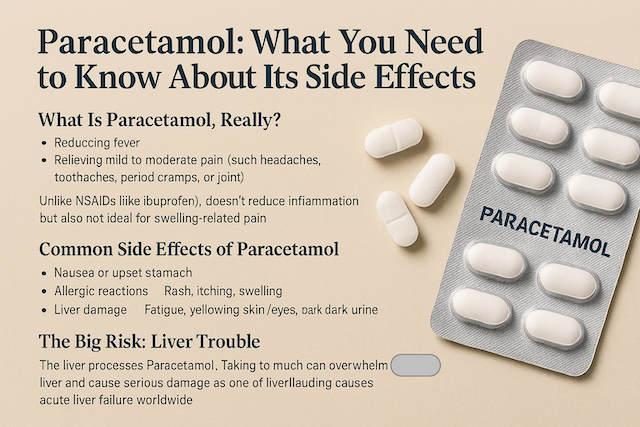Stay updated on what is trending in health. Discover tips and resources for a healthier, balanced life.
Paracetamol: What You Need to Know About Its Side Effects
Discover how paracetamol works, when to use it, and what side effects to watch for—including rare but serious risks like liver damage. This easy-to-understand guide covers safe dosing, hidden sources in other medications, and tips for responsible use across all age groups.
WELLNESS
Dr. S. Ali
9/24/20257 min read


Paracetamol (also known as acetaminophen) is one of the most commonly used painkillers in the world. Whether it’s a headache, fever, or muscle ache, chances are you’ve reached for a tablet at some point. But while it’s generally considered safe when used correctly, it’s not entirely risk-free.
Let’s break down what paracetamol does, how it works, and what side effects you should watch out for—without the medical jargon.
What Is Paracetamol, Really?
Paracetamol is one of those medications that quietly sits in most people’s medicine cabinets—and for good reason. It’s widely trusted for its ability to reduce fever and relieve mild to moderate pain, making it a go-to remedy for everyday discomforts like headaches, toothaches, menstrual cramps, and joint pain. Whether you're battling a seasonal flu or just trying to get through a tension headache, paracetamol often provides quick, reliable relief.
But here’s something many people don’t realize: paracetamol works differently from other common painkillers like ibuprofen or aspirin. Those drugs belong to a class called NSAIDs (non-steroidal anti-inflammatory drugs), which not only reduce pain but also tackle inflammation. Paracetamol, on the other hand, doesn’t have anti-inflammatory properties. That means it’s not the best choice if your pain is caused by swelling—like a sprained ankle or arthritis flare-up.
However, this difference comes with a silver lining. Because paracetamol doesn’t irritate the stomach lining the way NSAIDs can, it’s often safer for people with sensitive stomachs, ulcers, or those who can’t tolerate anti-inflammatory medications. It’s also generally considered safe for children and older adults when used at the correct dose.
In short, paracetamol is a gentle yet effective option for many types of pain and fever—but it’s important to know when it’s the right tool for the job.
Common Brand Names of Paracetamol
Paracetamol, also known as acetaminophen, is one of the most widely used over-the-counter medications for relieving pain and reducing fever. It’s marketed under numerous brand names across the globe.
Tylenol – Popular in the United States, Canada, and several other countries
Panadol – Widely available in Europe, Asia, Africa, and Australia
Calpol – Commonly used for children in the UK, India, and other regions
Crocin – Popular in India
Dafalgan – Available in Belgium, France, and Switzerland
Adol – Found in the Middle East (e.g., Kuwait, Oman)
Paracetamol (generic) – Often sold under the generic name in pharmacies worldwide
Despite the different names, the active ingredient remains the same, making these brands interchangeable in terms of therapeutic effect—though formulations and dosages may
Why People Trust Paracetamol
Paracetamol has earned its place as one of the most trusted medications worldwide—and it’s easy to see why. For starters, it’s widely available. You can walk into almost any pharmacy, supermarket, or corner store and find it on the shelf, no prescription needed. That kind of accessibility makes it a convenient first line of defense against everyday aches and fevers.
It’s also considered safe for most age groups, including children, older adults, and even pregnant women when used appropriately. Pediatric versions come in liquid form with carefully measured doses, and many doctors recommend it as a gentle option for managing pain in vulnerable populations.
Another reason people reach for paracetamol is that it’s easy on the stomach. Unlike NSAIDs (like ibuprofen or aspirin), paracetamol doesn’t irritate the stomach lining or increase the risk of ulcers. That makes it a preferred choice for people with digestive issues, acid reflux, or a history of gastrointestinal bleeding.
But here’s the catch: just because it’s common doesn’t mean it’s harmless. Its reputation for safety can lead to a false sense of security. People may assume it’s okay to take more than the recommended dose, mix it with alcohol, or overlook the fact that it’s hiding in other medications. And that’s where problems can start—especially when it comes to liver health.
So while paracetamol is a reliable ally, it’s important to treat it with the same respect you’d give any medication. Read the label, stick to the dosage, and don’t hesitate to ask your doctor or pharmacist if you’re unsure.
Common Side Effects of Paracetamol
Most people tolerate paracetamol well when taken as directed, but it’s still important to know what could go wrong—just in case. Here’s a breakdown of potential side effects:
Nausea or Upset Stomach
You might feel mildly queasy or experience slight stomach discomfort.
This is rare and usually goes away quickly.
Taking paracetamol with food can help minimize this effect.
Allergic Reactions
Very rarely, some people may develop a rash, itching, or swelling.
These symptoms could indicate an allergic response.
If you notice any of these signs, stop taking the medication and seek medical advice.
Liver Damage (Rare but Serious)
This is the most serious risk, especially if you take too much or mix it with alcohol.
Warning signs include fatigue, yellowing of the skin or eyes (jaundice), and dark-colored urine.
Liver damage can be life-threatening, so it’s crucial to stick to the recommended dose and avoid combining paracetamol with other medications that contain it. (Let’s discuss this a little more.)
The Big Risk: Liver Trouble
The liver processes paracetamol. If you take too much—either all at once or over time—it can overwhelm your liver and cause serious damage. In fact, paracetamol overdose is one of the leading causes of acute liver failure worldwide.
Watch out for:
While paracetamol is safe when used correctly, it’s surprisingly easy to misuse it without realizing. Here are three key things to watch out for:
1. Taking more than 4,000 mg per day That’s the maximum recommended dose for most adults—roughly 8 standard 500 mg tablets in 24 hours. Going over this limit, even by accident, can put serious strain on your liver. It’s especially risky if you’re taking it over several days or doubling up because the pain hasn’t gone away. Always space out your doses and follow the instructions on the label or from your doctor.
2. Mixing it with alcohol Alcohol and paracetamol both rely on your liver to be processed. When taken together, they can overwhelm your liver’s ability to cope, increasing the risk of liver damage. If you’ve had a few drinks, it’s best to avoid paracetamol altogether or consult a healthcare professional before taking it.
3. Using multiple medications that contain paracetamol This one catches a lot of people off guard. Many cold and flu remedies, sleep aids, and combination painkillers contain paracetamol—sometimes under different names like "acetaminophen." If you’re taking more than one product, you could be unknowingly doubling or tripling your dose. Always check the ingredients list and ask your pharmacist if you’re unsure.
When to Call a Doctor
You should reach out to a healthcare professional if:
You’ve accidentally taken more than the recommended dose (over 4,000 mg in 24 hours)
You experience symptoms like persistent nausea, vomiting, or abdominal pain
You notice signs of liver trouble—such as yellowing of the skin or eyes, dark urine, or unusual fatigue
You develop a rash, swelling, or difficulty breathing after taking paracetamol
You’re unsure whether it’s safe to take paracetamol with your existing medications or health conditions
When in doubt, it’s always better to check. Paracetamol is safe for most people—but your body deserves personalized care.
Is Paracetamol Safe for Kids?
Yes, paracetamol is generally safe for children—but only when given in the correct dose. It’s one of the most commonly recommended medications for kids dealing with fever, teething pain, or minor aches. Pediatric paracetamol usually comes in liquid form, and the dosage depends on both age and weight, not just one or the other.
Here’s what parents and caregivers should keep in mind:
Always use the measuring device provided—don’t guess with a kitchen spoon.
Double-check the label for the correct dose and timing.
Avoid giving adult-strength tablets unless specifically advised by a doctor.
If your child has other health conditions or is taking other medications, consult your pediatrician or pharmacist first.
Even though it’s widely used, paracetamol isn’t one-size-fits-all—especially for little ones.
Quick Tips for Safe Use (For Everyone)
To get the benefits of paracetamol without the risks, follow these simple but important safety tips:
Stick to the recommended dose Don’t exceed 4,000 mg per day for adults, and always follow age-appropriate dosing for children.
Don’t mix with alcohol Alcohol can increase the risk of liver damage when combined with paracetamol. If you’ve had a drink, it’s best to skip the dose or check with a healthcare provider.
Check labels for hidden paracetamol Many cold and flu remedies, sleep aids, and combination painkillers contain paracetamol under different names. Doubling up can happen easily if you’re not careful.
Talk to your doctor if you have liver disease or take other medications Paracetamol may interact with other drugs or worsen existing liver conditions. A quick chat with your doctor can help you avoid complications.
Final Thoughts: Respect the Pill
Paracetamol is one of the most trusted medications around—and for good reason. It’s effective, affordable, and generally safe when used correctly. But like any drug, it deserves respect. Misusing it, even unintentionally, can lead to serious health issues, especially for your liver.
So here’s the golden rule: don’t guess—ask. If you’re unsure about the right dose, whether it’s safe to combine with other meds, or if it’s the best choice for your symptoms, reach out to a healthcare professional. A quick question could save you from a long recovery.
Sources:
Drugs.com – Paracetamol Side Effects
https://www.drugs.com/sfx/paracetamol-side-effects.html
Healthdirect Australia – Paracetamol Overview
https://www.healthdirect.gov.au/paracetamol
NHS (UK) – Side Effects of Paracetamol for Adults
https://www.nhs.uk/medicines/paracetamol-for-adults/side-effects-of-paracetamol-for-adults/
The Kingsley Clinic – Paracetamol: Uses, Dosage, Side Effects
https://thekingsleyclinic.com/resources/paracetamol-uses-dosage-side-effects-and-safety-guidelines/
Drugs.com – Paracetamol Drug Info
https://www.drugs.com/paracetamol.html
Queensland Health – Safe Paracetamol Use Guidelines (PDF)
https://www.health.qld.gov.au/__data/assets/pdf_file/0016/1211443/guideline-safe-paracetamol-use.pdf
British Liver Trust – Paracetamol Overdose
https://britishlivertrust.org.uk/information-and-support/liver-conditions/paracetamol-overdose/
BMC Gastroenterology – Research Article on Liver Injury
https://bmcgastroenterol.biomedcentral.com/articles/10.1186/1471-230X-11-80
Pulse Your Health
Empowering you to achieve your health goals.
Contact
© 2025. All rights reserved.
Disclaimer: The content on this website is for informational purposes only and is not medical advice. Always seek the advice of your physician or other suitably qualified healthcare professional for diagnosis, treatment and your health related needs.
